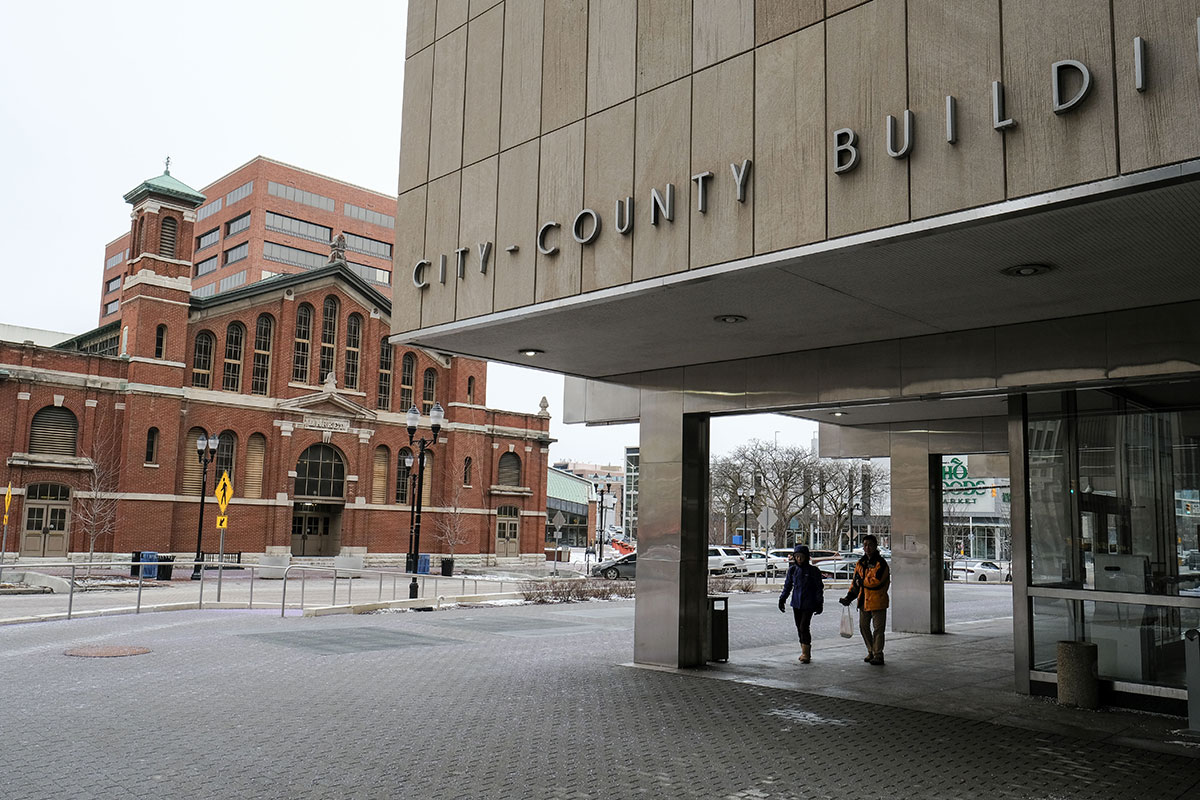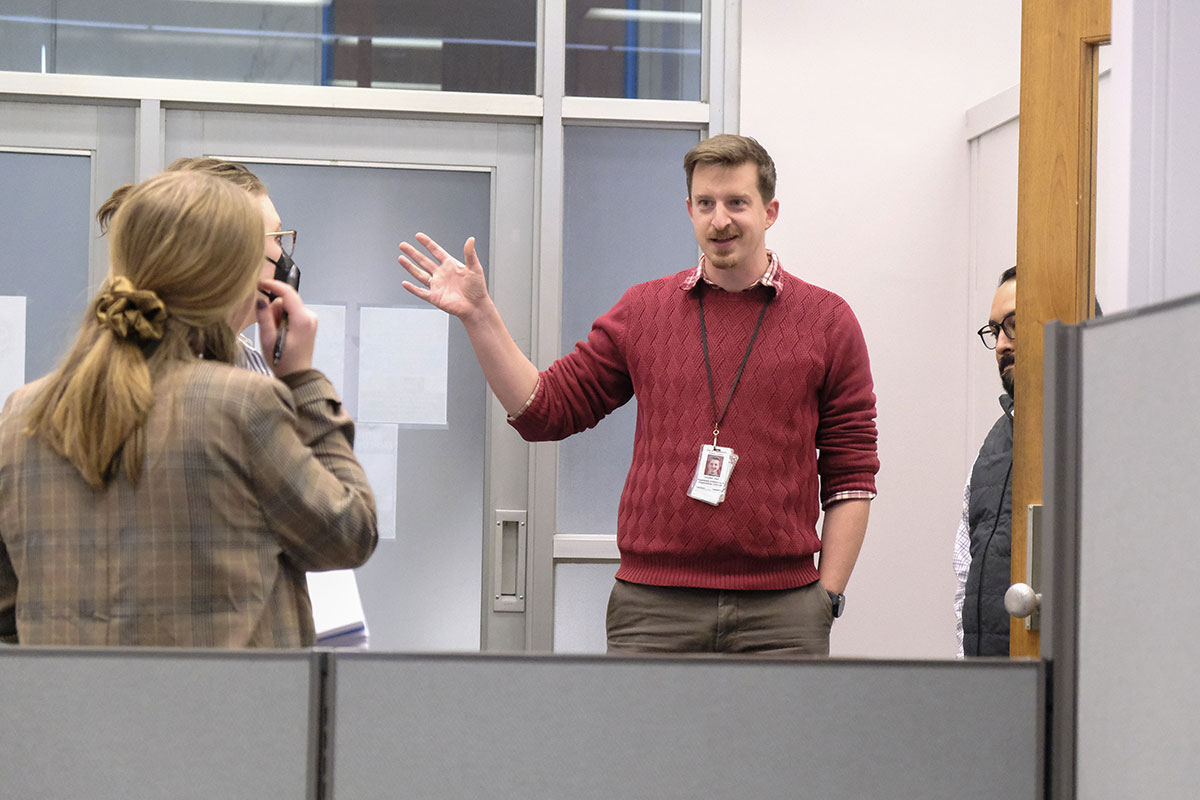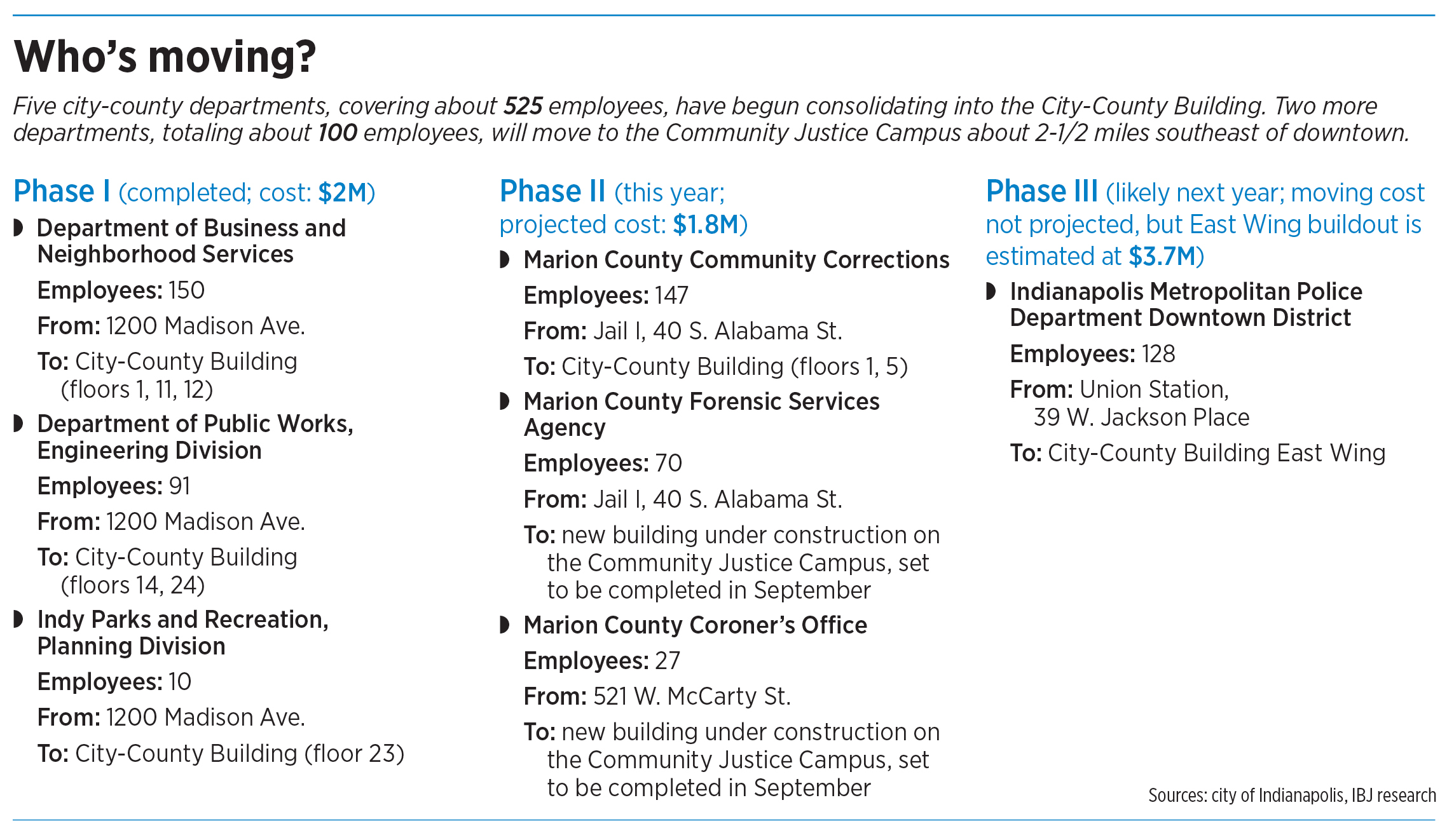Subscriber Benefit
As a subscriber you can listen to articles at work, in the car, or while you work out. Subscribe NowThe space on the City-County Building’s 12th floor didn’t initially look like much—blank walls, sticky notes indicating a need for new window blinds, empty cubicles with the names of employees on white printer paper—but for the Department of Business and Neighborhood Services, the new home was a big deal.
Kurt Christian, the department’s chief communications officer, described the agency’s former space at 1200 Madison Ave. as having a “1970s library basement vibe.”
The city had rented offices for the department there since 2008. The location was 2 miles south of the City-County Building, which is in the core of downtown on East Market Street. Employees felt cut off from other government agencies, and visitors often got lost wandering the six-story structure.
The relocation last fall kicked off a $7 million, three-phased move for several city agencies from various rented spaces to either the City-County Building or the new Community Justice Campus, on Southeastern Avenue. City officials say the moves will eventually bring cost savings, foster positive employee morale and improve services to the public.
The agency worked with an outside vendor to move most of the BNS department’s furniture, but Eva Flick, deputy director of the department, oversaw the process. The relocation created a modern, open-concept space that allows better collaboration. A labyrinth of interior walls wasn’t conducive to efficiently handling matters of building code compliance, inspections and permitting.
“We have found that things are much more lively, and, like, there’s definitely a stronger energy since we’ve been in this building versus when we were at Madison. … Our offices were next to each other, and it was still like miles away,” Flick told IBJ.
Plus, the new space has an amenity the Madison Avenue space didn’t: break rooms with kitchen sinks, “where you can wash your dishes in the sink instead of in the bathroom, which is huge,” Flick said.
The move also allowed the department to make space for new employees. Amy Wunder, deputy director of construction and business, told IBJ the office is seeking two program managers to oversee right-of-way and stormwater matters.
“[The move] really gave us the opportunity to reevaluate some of our existing organizational structure,” Wunder said.
The BNS move is just the start. When city-county courts moved in 2022 to the Community Justice Campus in the Twin Aire neighborhood 2-1/2 miles southeast of downtown, the City-County Building was left half empty. That opened plenty of space for agencies located off site to move in.
In the first phase of the transition, which cost $2 million, workers from the Parks and Recreation planning division and the Department of Public Works engineering division also vacated 1200 Madison Ave. That move—including the Department of Business and Neighborhood Services workers—involved about 250 employees.
In the upcoming second phase, workers with Marion County Community Corrections and Marion County Forensic Services Agency will vacate the former Jail I at 40 S. Alabama St. The building is set to be demolished by the end of the year to make room for redevelopment.
Corrections will move to the City-County Building in May. Forensics is expected to move this fall to a facility under construction now on the Community Justice Campus, as will the Marion County coroner. The coroner is currently in rented space on McCarty Street.
Phase II is projected to cost $1.8 million, city spokeswoman Aliya Wishner told IBJ in an email.
The administration is still planning the final phase. Moving costs have not been projected, but the city expects to spend $3.7 million on renovating the City-County Building’s east wing to make room for the Indianapolis Metropolitan Police Department Downtown District.
The district, currently in Union Station at 39 W. Jackson Place, will join other IMPD agencies in the east wing. The Downtown District includes officers with the homeless unit and mobile crisis assistance team.

Upfront cost, future saving
While the Hogsett administration expects to shell out more than $7 million for all the costs associated with the reshuffling, it estimates $450,000 in annual savings on operating costs. That’s based on the cost of renting and operating non-city-owned spaces compared with each agency’s costs in city-owned spaces.
In order to update the 62-year-old downtown tower and demolish the former Jail I, the Indianapolis Bond Bank is in the process of selling $23.3 million in facility revenue bonds.
Joe Glass, executive director of the Bond Bank, gave a presentation before the City-County Council Administration and Finance Committee in November where he laid out the City-County Building remodeling costs.
On the first floor, the city aims to create a more efficient and modern public-facing space for several city departments.
About $3 million of the bonds will fund the gutting of courtrooms and holding cells on the fourth and sixth floors. Those funds are also expected to pay for office furniture, flooring, wiring, appliances, updated break rooms, moving costs and a remodeling to fit IMPD workspaces in the east wing.
An update of the building’s electrical and HVAC systems is expected to cost $10 million.
Repairs to the city employee parking garage will cost just over $10 million and are expected to be complete by December. The city intends to ensure the garage is structurally sound, repair areas damaged by water leaks, reseal the structure with a water-resistant membrane and restripe the lot.
Although the City-County Building and Jail I are owned by the city of Indianapolis, the city pays an independent municipal corporation called the Marion County Building Authority to maintain and manage the spaces. Those payments cover rent (at a lower-than-average rate) utilities, maintenance and repairs.
After all the moves, the city will pay $358,000 to the Marion County Building Authority for the additional space it will use in the City-County Building, according to a representative from the building authority. Last year, the city paid $6.5 million to the agency.
The city pays the building authority $9 to $10 per square foot per year to occupy the City-County Building. At the end of last year, the average asking rent for Class A office space downtown was $24 to $25 per square foot per year, according to the local office of Chicago-based real estate firm Cushman & Wakefield.
Other city expenses will stop, such as rents paid for non-city-owned spaces. Ending the lease at 1200 Madison Ave. will save the administration $1.3 million a year by itself. The move will also eventually cut out rent, utilities and maintenance from Union Station, Jail I and the McCarty Street building that houses the Coroner’s Office.
Accessibility, collaboration
Along with the eventual savings, the relocations will bring city workers into a centralized location at the City-County Building with first-floor lobby spaces focused on public access.
The Department of Business and Neighborhood Services will have a lobby station where people with questions about permits can access kiosks or talk to a representative. The department had a self-service center at 1200 Madison, but the City-County Building center will include a scheduling tool that allows residents to choose a time to meet with the employee assigned to their case.
The relocation also gives the department the opportunity to work shoulder-to-shoulder with the agency’s “most relevant internal partners,” said Christian, the chief communications officer. These include the Department of Public Works, the Department of Metropolitan Development, the Treasurer’s Office and the Mayor’s Neighborhood Advocates.
Residents seeking assistance with permits used to have to drive to the Madison Avenue space and navigate an outdated building; they now can hop on a bus line to the Julia M. Carson Transit center a block from the City-County Building.
Beyond that, the department’s move has clearly improved employee morale in part due to nearby restaurants, Christian said. In the past, staff members who didn’t bring lunch had to drive to fast-food joints. Now they can walk to City Market or other local fare.
“Even on our first day here, I vividly remember, I don’t know that there was anyone that brought their lunch,” Business and Neighborhood Services’ Wunder added.
Scott Hohl, director of Marion County Community Corrections, echoed the benefits of working in a centralized location. His agency will move 147 employees from the former Jail I. He told IBJ in an email the new fifth-floor location will provide a better workplace environment and make the office easier for the general public to find. Eventually, that department, too, will have lobby kiosks. They’ll allow individuals on work release or other electronic monitoring to make fee payments.

What’s next?
The city’s Department of Metropolitan Development next plans to issue requests for proposals for redeveloping Union Station and the soon-to-be-leveled Jail I site.
And on East Market Street, the increase in the downtown workforce could set the stage for a more vibrant downtown in tandem with a major redevelopment.
Across the street from the City-County Building, Indianapolis-based developers Citimark and Gershman Partners are overseeing a $300 million project to remake the City Market block. The project includes redeveloping the iconic 20-story Gold Building into 350 apartments, along with constructing an 11-story, 60-unit apartment tower to replace City Market’s east wing, updates to an office building at the southwest corner of Ohio and Alabama streets, and an expansion of the market itself.
Construction is set to begin next month.
In a release announcing the city department moves back in September, Mayor Joe Hogsett presented the relocations as part of his administration’s downtown revitalization strategy.
“This announcement matches our commitment to saving taxpayer dollars with our commitment to a vibrant downtown,” Hogsett said. “We’re proud to lead by example in maintaining a robust downtown workforce. And in the process, we’re making local government as accessible as ever.”•
Please enable JavaScript to view this content.



Sounds like a great plan overall.
Will the metal detectors (and the need to remove belts) removed now that the Sheriff’s department and Courts have vacated the building? Or will we never return to a civil manner of entry to meet with our public servants?
Making another mountain out of a molehill I see.
Even many nongovernmental large office buildings have metal detectors and other forms of security, including often armed guards. Many schools do, too. Especially in this day and age of frequent mass shootings, I am not sure what you perceive as uncivil about security?
But, the good news for you is that modern technology allows us to conduct most business, including many interactions with city departments, online. So, you can avoid much (albeit not yet all) of the incivility and hassle of having to go to the City-County Building in person. Stay at home, kick back, and log in. One day, you will never need to talk to a live person again! Hallelujah!